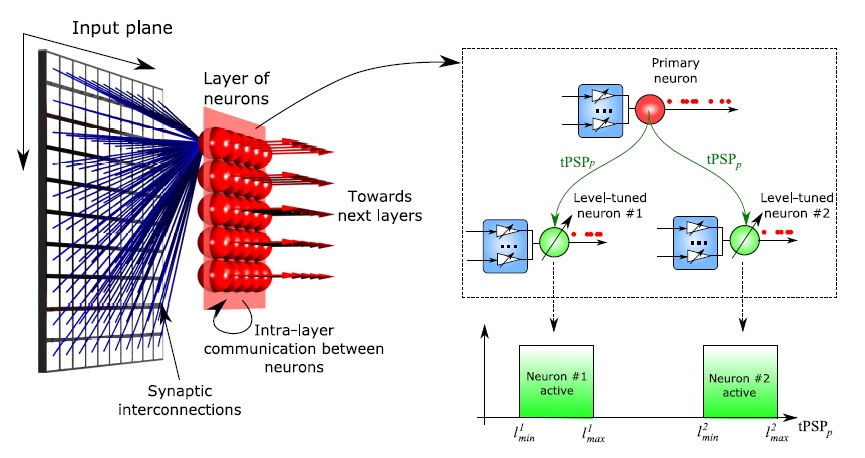Ahmedabad
(Head Office)Address : 506, 3rd EYE THREE (III), Opp. Induben Khakhrawala, Girish Cold Drink Cross Road, CG Road, Navrangpura, Ahmedabad, 380009.
Mobile : 8469231587 / 9586028957
Telephone : 079-40098991
E-mail: dics.upsc@gmail.com

Neuromorphic Computing
News: Recently, a team of scientists from Jawaharlal Nehru Centre for Advanced Scientific Research (JNCASR) has developed Artificial Synapse for Brain-Like Computing or Neuromorphic Computing.
• They have used scandium nitride (ScN), a semiconducting material with supreme stability and Complementary Metal-Oxide-Semiconductor (CMOS) compatibility, to develop brain-like computing.
What is Neuromorphic Computing?
• Neuromorphic Computing refers to the designing of computers that are based on the systems found in the human brain and the nervous system.
• Neuromorphic computing devices can work as efficiently as the human brain without acquiring large room for the placement of software.
• One of the technological advancements that has rekindled the interest of scientists in neuromorphic computing is the development of the Artificial Neural Network model (ANN).
How does it work?
• The working mechanism of neuromorphic computing involves the use of Artificial Neural Networks (ANN) made up of millions of artificial neurons, similar to those in the human brain. These neurons pass signals to each other in layers, converting input into output through electric spikes or signals, based on the architecture of Spiking Neural Networks (SNN).
•This allows the machine to mimic the neuro-biological networks in the human brain and perform tasks efficiently and effectively, such as visual recognition and data interpretation.
What is the significance of study?
• Neuromorphic hardware aims at mimicking a biological synapse that monitors and remembers the signal generated by the stimuli. ScN is used to develop a device mimicking a synapse that controls the signal transmission as well as remembers the signal.
• This invention can provide a new material for stable, CMOS-compatible optoelectronic synaptic functionalities at a relatively lower energy cost and hence has the potential to be translated into an industrial product.
• The traditional computers have physically separated memory storage and processing units. As a result, it takes enormous energy and time to transfer data between these units during an operation.
• On the contrary, the human brain is a supreme biological computer that is smaller and more efficient due to the presence of a synapse (the connection between two neurons) that plays the role of both processor and memory storage unit.
• In the current era of artificial intelligence, the brain-like computing approach can help meet the escalating computational demands.
• With the help of one of the techniques of AI, (machine learning), neuromorphic computing has advanced the process of information processing and enabled computers to work with better and bigger technology.

Address : 506, 3rd EYE THREE (III), Opp. Induben Khakhrawala, Girish Cold Drink Cross Road, CG Road, Navrangpura, Ahmedabad, 380009.
Mobile : 8469231587 / 9586028957
Telephone : 079-40098991
E-mail: dics.upsc@gmail.com
Address: A-306, The Landmark, Urjanagar-1, Opp. Spicy Street, Kudasan – Por Road, Kudasan, Gandhinagar – 382421
Mobile : 9723832444 / 9723932444
E-mail: dics.gnagar@gmail.com
Address: 2nd Floor, 9 Shivali Society, L&T Circle, opp. Ratri Bazar, Karelibaugh, Vadodara, 390018
Mobile : 9725692037 / 9725692054
E-mail: dics.vadodara@gmail.com
Address: 403, Raj Victoria, Opp. Pal Walkway, Near Galaxy Circle, Pal, Surat-394510
Mobile : 8401031583 / 8401031587
E-mail: dics.surat@gmail.com
Address: 303,305 K 158 Complex Above Magson, Sindhubhavan Road Ahmedabad-380059
Mobile : 9974751177 / 8469231587
E-mail: dicssbr@gmail.com
Address: 57/17, 2nd Floor, Old Rajinder Nagar Market, Bada Bazaar Marg, Delhi-60
Mobile : 9104830862 / 9104830865
E-mail: dics.newdelhi@gmail.com